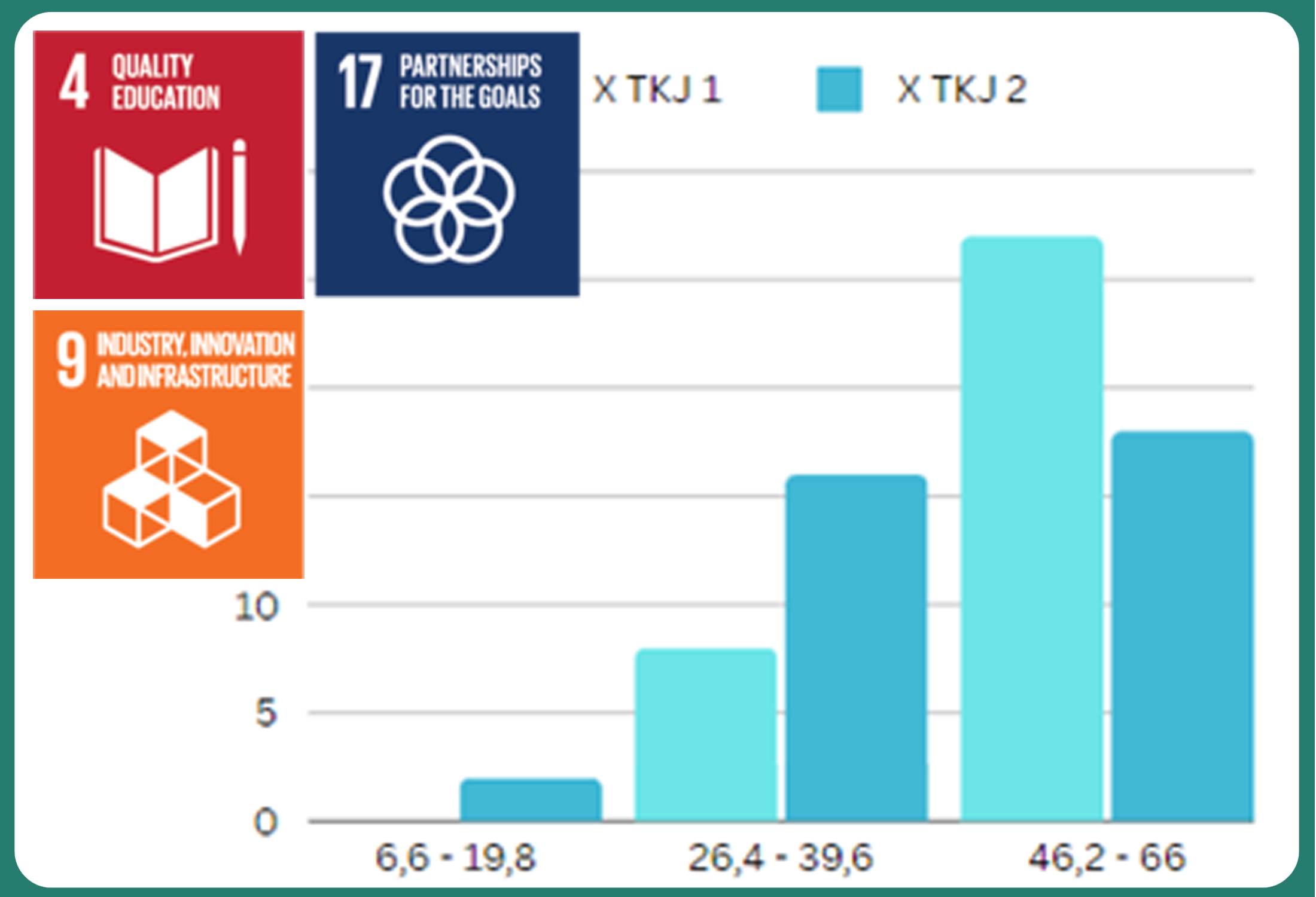Analysis of the Use of Augmented Reality-Based Learning Media on Conceptual Understanding Ability
DOI:
https://doi.org/10.24036/javit.v5i1.239Keywords:
Augmented Reality, Learning Media, Computer hardware, Informatics, Conceptual understandingAbstract
In the era of technological advancement, education must continually innovate by utilizing effective learning media, such as augmented reality (AR). AR creates an interactive and engaging learning environment by combining real-world visualization with virtual objects, making it a focus in education to enhance conceptual understanding. This study aims to analyze the validity, practicality, and effectiveness of AR-based learning media in improving students' conceptual understanding of computer hardware materials in Informatics subjects. The research was conducted in classes X TKJ 1 and X TKJ 2 at SMK Negeri 5 Padang, using multiple-choice objective test instruments and questionnaires. The results indicate that the use of AR-based learning media has a significant impact on improving students' conceptual understanding. This is evidenced by the hypothesis test results showing a sig. (2-tailed) value of 0.00 (<0.05) and an N-gain score of 0.7293 (high category), with an effectiveness percentage of 72.92%. AR-based learning media was deemed highly feasible as supplementary learning media based on expert validation (95%), as well as practicality questionnaires from teachers (95%) and students (87%). The advantages of AR media include realistic visualization, the ability for repeated observation, a more interactive learning experience, and efficiency in the use of teaching aids. Thus, the implementation of AR in learning has proven effective in enhancing students’ conceptual understanding and providing a more engaging and meaningful learning experience.
Downloads
References
M. K. Budiarto, A. Rahman, Asrowi, Gunarhadi, and A. Efendi, “Proposing information and communication Technology (ICT)-Based Learning transformation to create competitive human resources: A theoretical review,” Multidiscip. Rev., vol. 7, no. 4, pp. 2024076–2024076, Feb. 2024, https://doi.org/10.31893/multirev.2024076.
J. Muzam, “The Challenges of Modern Economy on the Competencies of Knowledge Workers,” J. Knowl. Econ., vol. 14, no. 2, pp. 1635–1671, Jun. 2023, https://doi.org/10.1007/s13132-022-00979-y.
N. M. Tri, P. D. Hoang, and N. T. Dung, “Impact of the industrial revolution 4.0 on higher education in Vietnam: challenges and opportunities,” Linguist. Cult. Rev., vol. 5, no. S3, pp. 1–15, Jul. 2021, https://doi.org/10.21744/lingcure.v5ns3.1350.
E. Ukpe, “Information and Communication Technologies (ICTS) for E-Learning in Tertiary Education,” Open J. Soc. Sci., vol. 11, no. 12, pp. 666–680, Dec. 2023, https://doi.org/10.4236/jss.2023.1112044.
P. S. Aithal and A. K. Maiya, “Innovations in Higher Education Industry – Shaping the Future,” Int. J. Case Stud. Business, IT, Educ., pp. 294–322, Nov. 2023, https://doi.org/10.47992/ijcsbe.2581.6942.0321.
D. Safitri, A. Marini, A. F. Auliya, Sujarwo, and P. A. Wardhani, “Development of Augmented Reality-based Interactive Learning Media to Increase Interest in Environmental Education,” Eurasian J. Educ. Res., vol. 2023, no. 106, pp. 101–117, 2023, https://doi.org/10.14689/ejer.2023.106.007.
S. Vashisht, “Enhancing Learning Experiences Through Augmented Reality and Virtual Reality in Classrooms,” 2nd IEEE Int. Conf. Recent Adv. Inf. Technol. Sustain. Dev. ICRAIS 2024 - Proc., pp. 12–17, 2024, https://doi.org/10.1109/ICRAIS62903.2024.10811732.
H. Ateş, “Integrating augmented reality into intelligent tutoring systems to enhance science education outcomes,” Educ. Inf. Technol., vol. 30, no. 4, pp. 4435–4470, Aug. 2024, https://doi.org/10.1007/s10639-024-12970-y.
P. Jain et al., “Real-Time Interactive AR for Cognitive Learning,” Signals Commun. Technol., vol. Part F1223, pp. 219–239, 2023, https://doi.org/10.1007/978-3-031-29713-7_12.
F. Khairiyah, M. Ramdan, and H. Suharyati, “Application of Augmented Reality-Based Learning Technology to Information Processing and Memory in Vocational High Schools: A Literature Review,” Int. J. Sustain. Dev. Futur. Soc., vol. 2, no. 2, pp. 54–61, Nov. 2024, https://doi.org/10.62157/IJSDFS.V2I2.72.
Y. Liu, Q. Zhan, and W. Zhao, “A systematic review of VR/AR applications in vocational education: models, affects, and performances,” Interact. Learn. Environ., Nov. 2023, https://doi.org/10.1080/10494820.2023.2263043.
H. Yu, “The application and challenges of ChatGPT in educational transformation: New demands for teachers’ roles,” Heliyon, vol. 10, no. 2, Jan. 2024, https://doi.org/10.1016/j.heliyon.2024.e24289.
H. L. Overskott, C. E. Markholm, A. Sehic, and Q. Khan, “Different Methods of Teaching and Learning Dental Morphology,” Dent. J., vol. 12, no. 4, p. 114, Apr. 2024, https://doi.org/10.3390/dj12040114.
A. A. Khafizova, A. M. Galimov, S. R. Kharisova, L. Y. Grebenshchikova, R. I. Yagudina, and L. M. Smirnova, “The impact of healthcare digitalization on the medical education curricula and programs: Points of convergence and divergence,” Contemp. Educ. Technol., vol. 15, no. 4, p. ep479, Oct. 2023, https://doi.org/10.30935/CEDTECH/13768.
R. Hidayati, A. S. Kusmanto, and A. Kiswantoro, “Development and Construct Validation of Indonesian Students Self-Confidance Scale Using Pearson Product Moment,” Pegem J. Educ. Instr., vol. 13, no. 3, pp. 94–103, Jul. 2023, https://doi.org/10.47750/pegegog.13.03.11.
S. C. Izah, L. Sylva, and M. Hait, “Cronbach’s Alpha: A Cornerstone in Ensuring Reliability and Validity in Environmental Health Assessment,” ES Energy Environ., vol. 23, Mar. 2024, https://doi.org/10.30919/esee1057.
G. N. S. Agustika, “The Influence of Augmented Reality-Based Learning Media on the Students’ Achievement of Mathematics,” Proc. 2nd Int. Conf. Technol. Educ. Sci. (ICTES 2020), vol. 540, pp. 47–56, Apr. 2021, https://doi.org/10.2991/assehr.k.210407.212.
H. Nindiasari et al., “The Use of Augmented Reality To Improve Students’ Geometry Concept Problem-Solving Skills Through the Steam Approach,” Infin. J., vol. 13, no. 1, pp. 119–138, Jan. 2024, https://doi.org/10.22460/infinity.v13i1.p119-138.
A. Neyem et al., “Enhancing medical anatomy education with the integration of virtual reality into traditional lab settings,” Clin. Anat., vol. 38, no. 3, pp. 249–268, Apr. 2024, https://doi.org/10.1002/ca.24213.
C. Wang, Y. Tang, M. A. Kassem, H. Li, and B. Hua, “Application of VR technology in civil engineering education,” Comput. Appl. Eng. Educ., vol. 30, no. 2, pp. 335–348, Mar. 2022, https://doi.org/10.1002/cae.22458.
K. Hisley, “An Overview of Traditional and Advanced Visualization Techniques Applied to Anatomical Instruction Involving Cadaveric Dissection,” Adv. Exp. Med. Biol., vol. 1431, pp. 35–63, 2023, https://doi.org/10.1007/978-3-031-36727-4_3.
G. Baxter and T. Hainey, “Using immersive technologies to enhance the student learning experience,” Interact. Technol. Smart Educ., vol. 21, no. 3, pp. 403–425, Jul. 2024, https://doi.org/10.1108/ITSE-05-2023-0078.
R. Al Shawabkeh and M. Arar, “The role of virtual reality in improving neighborhood park design: A comparative study of virtual reality and traditional approaches,” Int. J. Geoheritage Park., vol. 12, no. 1, pp. 75–97, Jun. 2024, https://doi.org/10.1016/j.ijgeop.2024.02.001.
S. Dargan, S. Bansal, M. Kumar, A. Mittal, and K. Kumar, “Augmented Reality: A Comprehensive Review,” Arch. Comput. Methods Eng., vol. 30, no. 2, pp. 1057–1080, Mar. 2023, https://doi.org/10.1007/S11831-022-09831-7.
E. Childs et al., “An Overview of Enhancing Distance Learning Through Emerging Augmented and Virtual Reality Technologies,” IEEE Trans. Vis. Comput. Graph., vol. 30, no. 8, pp. 4480–4496, 2024, https://doi.org/10.1109/TVCG.2023.3264577.
L. RUI, N. MOHAMAD NASRI, and S. N. D. MAHMUD, “The Role of Self-directed Learning in Promoting Deep Learning Processes: A Systematic Literature Review,” F1000Research, vol. 13, p. 761, Jul. 2024, https://doi.org/10.12688/f1000research.150612.1.
D. Alt and N. Raichel, “Problem-based learning, self- and peer assessment in higher education: towards advancing lifelong learning skills,” Res. Pap. Educ., vol. 37, no. 3, pp. 370–394, May 2022, https://doi.org/10.1080/02671522.2020.1849371.
X. F. Lin et al., “Effects of a contextualised reflective mechanism-based augmented reality learning model on students’ scientific inquiry learning performances, behavioural patterns, and higher order thinking,” Interact. Learn. Environ., vol. 31, no. 10, pp. 6931–6951, Dec. 2023, https://doi.org/10.1080/10494820.2022.2057546.
N. Yuniarti et al., “Augmented reality-based higher order thinking skills learning media: Enhancing learning performance through self-regulated learning, digital literacy, and critical thinking skills in vocational teacher education,” Eur. J. Educ., vol. 59, no. 4, p. e12725, Dec. 2024, https://doi.org/10.1111/ejed.12725.
E. Ahdhianto, Y. K. Barus, and M. A. Thohir, “Augmented reality as a game changer in experiential learning: Exploring its role cultural education for elementary schools,” J. Pedagog. Res., vol. 9, no. 1, pp. 296–313, 2025, https://doi.org/10.33902/JPR.202533573.
M. A. M. AlGerafi, Y. Zhou, M. Oubibi, and T. T. Wijaya, “Unlocking the Potential: A Comprehensive Evaluation of Augmented Reality and Virtual Reality in Education,” Electron., vol. 12, no. 18, p. 3953, Sep. 2023, https://doi.org/10.3390/electronics12183953.
E. L. C. Law and M. Heintz, “Augmented reality applications for K-12 education: A systematic review from the usability and user experience perspective,” Int. J. Child-Computer Interact., vol. 30, p. 100321, Dec. 2021, https://doi.org/10.1016/j.ijcci.2021.100321.
J. Cao, K. Y. Lam, L. H. Lee, X. Liu, P. Hui, and X. Su, “Mobile Augmented Reality: User Interfaces, Frameworks, and Intelligence,” ACM Comput. Surv., vol. 55, no. 9, p. 189, Sep. 2023, https://doi.org/10.1145/3557999.

Downloads
Published
How to Cite
Issue
Section
License
Copyright (c) 2025 Syifa Urrahmah, Elfi Tasrif, Vera Irma Delianti, Lativa Mursyida

This work is licensed under a Creative Commons Attribution 4.0 International License.










